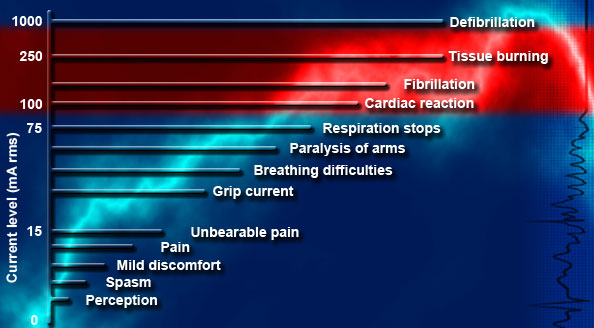OHS practices - Hazards
Electrical
Electricity is dangerous because we normally cannot sense its presence from smell, taste, hearing or sight. The hazards of electric cables or switches are not apparent and we may not be aware of a hazard that lies only millimetres away.
When a certain level of electric current passes through the body, tissues start to break down. If the current passes from the upper torso or hands to the feet or ground, the electricity passes through the heart and causes it to stop beating. The severity of the electric shock is, therefore, dependent on the level of current and the period of exposure.
Electrocution is a term used to indicate a fatal electric shock; not all electric shocks are fatal.

Possible reactions to 50 Hz rms current
Electrical effects
Electrical hazards can cause:
- burns
- electric shock
- fire
- other injuries from falls and jolts.
Electric shock can cause:
- internal bleeding
- destruction of tissues
- destruction of nerves and muscles
- respiratory arrest (breathing stops)
- asphyxia (suffocation)
- irregular heart beat
- death.
Electricity travels in a closed loop and shock occurs when your body becomes a part of that loop. For this to happen, the current must enter the body at one point and leave at another.
Electric shock normally occurs when a person comes into contact with:
- both wires of a circuit
- one wire of a circuit and the ground
- a metal part which is in contact with a circuit.
Current will always flow to earth along the easiest route. That route is called the 'path of least resistance'.
How severe the electric shock is depends on:
- the amount of current passing through the body
- the state of health of the victim
- the type of electrical supply
- the resistance of the skin and clothing
- the current path through the body (through the heart is very dangerous)
- the time it is in the body.



